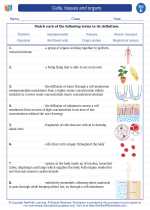Cells, tissues and organs -> climate
Climate
Definition
Climate refers to the long-term patterns and averages of temperature, precipitation, humidity, wind, and other atmospheric conditions in a particular region. It is the typical weather conditions that occur in an area over a long period of time, typically 30 years or more.
Factors Affecting Climate
Several factors influence the climate of a region, including:
- Latitude: The distance from the equator affects the amount of sunlight a region receives, which in turn influences temperature and climate.
- Altitude: Higher altitudes generally have cooler temperatures due to lower air pressure and decreased ability to retain heat.
- Distance from the sea: Coastal areas experience more moderate temperatures due to the ocean's ability to moderate climate through its heat capacity.
- Ocean currents: Ocean currents can transport warm or cold water, impacting the climate of coastal regions.
- Topography: The shape of the land, such as mountains and valleys, can affect local climate by influencing wind patterns and precipitation.
- Vegetation and land use: The type of vegetation cover and human activities can impact the local climate through factors such as evaporation, transpiration, and albedo.
Climate Zones
There are several major climate zones on Earth, including:
- Tropical: Characterized by warm temperatures and high humidity, found near the equator.
- Temperate: Moderate climate with distinct seasons, found in the mid-latitudes.
- Polar: Cold climate with little precipitation, found near the poles.
- Continental: Regions with hot summers and cold winters, often found in the interior of continents.
- Highland: Varied climate based on elevation, found in mountainous regions.
Effects of Climate Change
Climate change refers to long-term shifts in temperature, precipitation, and other atmospheric conditions, often attributed to human activities such as burning fossil fuels and deforestation. The effects of climate change include:
- Rising global temperatures
- Extreme weather events
- Changes in precipitation patterns
- Sea level rise
- Impact on ecosystems and biodiversity
- Effects on agriculture and food security
Study Guide
To study and understand the topic of climate, it is important to:
- Learn about the factors that influence climate, such as latitude, altitude, and ocean currents.
- Explore the different climate zones and their characteristics.
- Understand the concept of climate change and its potential effects on the planet.
- Examine real-world examples of climate change and its impact on specific regions and ecosystems.
- Consider the ways in which individuals and communities can mitigate and adapt to climate change.
By understanding the complexities of climate and climate change, we can make informed decisions to protect our environment and work towards a sustainable future.
[Climate] Related Worksheets and Study Guides:
.◂Science Worksheets and Study Guides Fifth Grade. Cells, tissues and organs

 Worksheet/Answer key
Worksheet/Answer key
 Worksheet/Answer key
Worksheet/Answer key
 Worksheet/Answer key
Worksheet/Answer key
 Vocabulary/Answer key
Vocabulary/Answer key
 Vocabulary/Answer key
Vocabulary/Answer key
 Vocabulary/Answer key
Vocabulary/Answer key
 Vocabulary/Answer key
Vocabulary/Answer key
 Vocabulary/Answer key
Vocabulary/Answer key
 Vocabulary/Answer key
Vocabulary/Answer key
